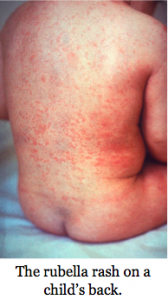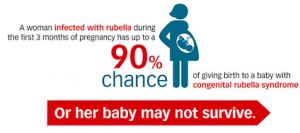 Virus: Rubella Virus, a togavirus
Virus: Rubella Virus, a togavirus
Vaccine: MMR or MMRV
Transmission:
Rubella is a virus that is spread by coughing and sneezing. It is also spread through contact with respiratory droplets.
Symptoms:

Rubella mostly is an infection of the skin lymph nodes and causes a rash. The infection begins with a few days of mild fever and swollen, tender lymph nodes, usually in the back of the neck or behind the ears, followed by a rash that begins on the face and spreads downward. The rash, which tends to look like many common childhood rashes, comes as pink or red spots, which might merge to form evenly-colored patches and tends to last for about three days. It may also be itchy. Once the rash clears, the skin sometimes sheds in fine flakes, and the lymph nodes may remain swollen for a week or more.
Along with the symptoms mentioned above, OLDER children who contract rubella may have a headache, loss of appetite, mild inflammation of the eyes, a stuffy or runny nose, swollen lymph nodes in other parts of the body, and pain and swelling in the joints (especially in young women), that may last for a few weeks.
It is also common to show no symptoms when infected with rubella, however it is important to understand that if infected and asymptomatic, your child may still be contagious to others and can still spread the virus.
Who is at Risk:
All children and those who are immunocompromised are at higher risk of contracting rubella. College students or those living in close quarters, health care workers, people traveling internationally, and women of childbearing age are among those who are in even greater need of the vaccine.
Possible Complications:
Some women that contract rubella experience arthritis in the fingers, wrists and knees, which generally lasts for about one month.
In rare cases, rubella can cause an ear infections or inflammation of the brain.
Pregnancy/Unborn Child/Newborn Risk:
Should you be pregnant and think you may have come into contact with rubella, you need to contact your doctor immediately. The highest risk to the fetus is during the first trimester, but exposure later in pregnancy also is dangerous. Rubella can cause miscarriage and congenital rubella syndrome. This may lead to potentially devastating birth defects in the unborn child.
These babies are at risk for: growth retardation, malformations of the heart and eyes, deafness, mental retardation, liver and spleen damage, and bone marrow problems.
 Babies that are born with congenital rubella syndrome can spread rubella for up to a year, and may pass the virus through urine and fluids from the nose/throat to others who are not immunized.Due to the measles, mumps, and rubella (MMR) vaccine, rubella and congenital rubella syndrome can be prevented. Before we had this vaccine, there were epidemics occurring about every 6-9 years in mostly kids between the ages of 5 and 9 years old, as well as many congenital cases of rubella.2
Babies that are born with congenital rubella syndrome can spread rubella for up to a year, and may pass the virus through urine and fluids from the nose/throat to others who are not immunized.Due to the measles, mumps, and rubella (MMR) vaccine, rubella and congenital rubella syndrome can be prevented. Before we had this vaccine, there were epidemics occurring about every 6-9 years in mostly kids between the ages of 5 and 9 years old, as well as many congenital cases of rubella.2
Prevention:
Due to vaccination, the instance of rubella in the US is very low. The only way to prevent rubella is to get vaccinated with MMR or MMRV.
Treatment:
Rubella is typically mild in kids, who often can be cared for at home. Just make sure that if your child become infected and sick with rubella, to monitor your child’s fever and call the doctor should it climb too high or if your child appears to be getting sicker than the mild symptoms listed above.
Prognosis:
Rubella is generally a mild disease and prognosis is good, however babies who contract rubella in-utero are at high risk for complications.
Resources:
- Medline Plus. U.S. National Library of Medicine. www.nlm.nih.gov
- Centers for Disease Control and Prevention (CDC). www.cdc.gov
- National Institutes of Health. www.nih.gov
- Kids Health. Nemours. www.kidshealth.org
- The history of Vaccines. www.historyofvaccines.org
- National Institute of Neurological Disorders and Stroke. www.ninds.nih.gov
All photos courtesy of the CDC. www.cdc.gov
